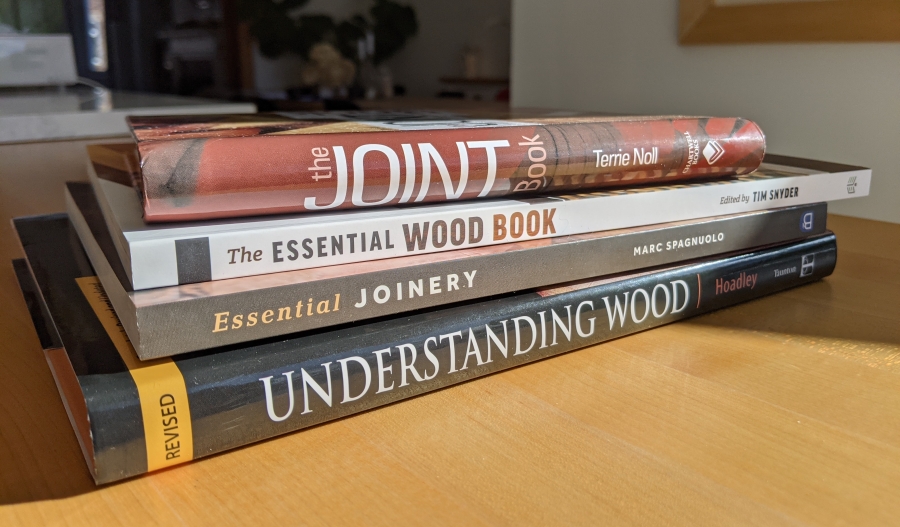
When I think of woodworking books, I think… B-O-R-I-N-G. Am I right? I mean, ever since I first started my woodworking journey, not once have I ever read an actual book about woodworking and that’s because I’ve always thought of them as outdated.
I always picture some old dude in the 80’s who wrote a book about traditional furniture making using traditional tools. I’m sure he was plenty knowledgeable and a master of the subject, sure. But I want to build modern furniture, using modern tools and techniques, you know?
Hmm, okay, then why are you starting a woodworking book of the month series? Well, that’s an excellent question.
You may not know this about me, but I don’t have any formal training in woodworking or carpentry, and it doesn’t run in the family either. I’ve only been dabbling in it part-time for the past 5 years or so. Everything I’ve learned has been self-taught through YouTube, online research, and “on the job learning”.
Woodworking Reference Books
I’ve learned so much on YouTube and recognize that video tutorials are by far more insightful than words written on a page – why do you think I started a YouTube channel? – but there are limitations to YouTube:
- Number one: Not everyone on YouTube actually knows what they’re doing, so the information you get there may be either incomplete or inaccurate, or both.
- Number two: It’s very difficult or almost impossible to find a complete reference on YouTube that will give you all the required knowledge and understanding of a skill, technique, method or whatever aspect of woodworking you’re interesting in learning. You might get a good base to start you off, or enough info to give you the courage to try a project yourself, but in my opinion, it will never be as thorough as a book.
When I pick up a book on the other hand, I assume two things:
- That the author likely has extensive knowledge and experience in the subject being covered in the book.
- That the author has done extensive research and fact checking before publishing the book.
Would you make the same assumptions about all YouTubers? Personally, as a YouTuber myself, I can tell you that I do some research before putting out a video, but I am definitely not an expert in what I’m putting out there. In fact, most of the time I’m trying the technique, method or given project for the very first time, like when I tested out 4 different ways to cut circles in wood.
“So what’s the point”, you may ask? My point is that I believe woodworking books still have a lot of value to offer.
The Value of Woodworking books
At this point in my woodworking journey, I’ve decided to take a step back and learn some of the basics of the trade, so I’ve set out a goal to read one woodworking book each month and share my review with you. I’ll share insights into what the book focuses on, things that I learned (or didn’t) and who I might recommend this book to. I’ll share the pros and cons, and general impressions overall.
Now, you won’t be surprised to learn that there are actually a considerable number of woodworking books out there! Some are considered classics and come up in practically any keyword search you might do on the subject, while others you really have to search for to find them. Some books focus on specific projects and how to build them, while other focus on specific topics or techniques, like joinery or wood movement. Then there are those who strive to be the all-encompassing encyclopedia of woodworking, covering every single topic under the sun, from setting up your shop, to what tools to use, to techniques, buying lumber, projects and everything else they could cram into one book – I won’t be exploring these ones.
Woodworking Book Reviews
So what types of woodworking books will I review? For this woodworking book of the month series, I have decided to focus on the second type outlined above, that is books that cover specific woodworking topics or techniques. Some of the books I’ve already ordered focus on understanding wood movement, joinery techniques, and finishing wood. These are just a few to get me started, but I hope to dive into furniture design, cabinet making basics, sharpening, and so on.
If you want to join me and read the book alongside me, allow me to share the title of the first book I’ll be reading this month: Understanding Wood: A Craftsman’s Guide to Wood Technology. It’s an older book, for sure (originally published in 1980 and updated in 2000), but it is widely held as a definitive reference work and the cornerstone of every woodworker’s library. Some would consider it a “woodworking bible” (although it reads more like a textbook) where the author delves into the nature of wood and how its structure affects strength, workability, and other characteristics.
Be sure to check back in for that review and stay tuned for a new book review every month.
Woodworking Books Reviewed to Date:
- Understanding Wood: A Craftsman’s Guide to Wood Technology by R. Bruce Hoadley
- Essential Joinery: The Fundamental Techniques Every Woodworker Should Know by Marc Spagnuolo
- Understanding Wood Finishing: How to Select and Apply the Right Finish by Bob Flexner
- New Complete Guide to Band Saws: Everything You Need to Know About the Most Important Saw in the Shop by Mark Duginske
